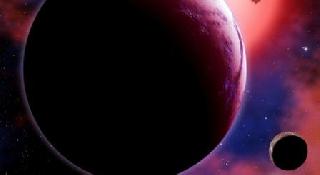
The planet GJ 1214b, shown here in an artist's conception with two hypothetical moons, orbits a "red dwarf" star 40 light-years from Earth. Photo by CfA/David Aguilar
PASADENA, CALIFORNIA (BNS): Astronomers have made the first characterizations of a super-Earth's atmosphere using a ground-based telescope.
A super-Earth is a planet up to three times the size of Earth and weighing up to 10 times as much.
A team of astronomers examined the planet GJ 1214b using the ground-based Very Large Telescope at Paranal Observatory in Chile.
They determined that the planet is either blanketed with a thin layer of water steam or surrounded by a thick layer of high clouds.
If the former, the planet itself would have an icy composition. If the latter, the planet would be rocky or similar to the composition of Neptune, though much smaller.
GJ 1214b, first discovered in December 2009, is 2.7 times the size of Earth and 6.5 times as massive. The planet orbits close to its dim star, at a distance of 0.014 astronomical units.
"This is the first super-Earth known to have an atmosphere," said Jacob Bean, a NASA Sagan Fellow and astronomer at the Harvard-Smithsonian Center for Astrophysics in Cambridge, Massachusettes.
Bean and his team observed infrared light as the planet crossed in front of its star. During such transits, the star's light filters through the atmosphere. Gases absorb the starlight at particular wavelengths, leaving behind chemical fingerprints detectable from Earth.
"A steamy atmosphere would have to be very dense – about one-fifth water vapour by volume -- compared to our Earth, with an atmosphere that's four-fifths nitrogen and one-fifth oxygen with only a touch of water vapor," Bean said.
"During the next year, we should have some solid answers about what this planet is truly like."
The findings reported in the journal Nature are a significant milestone toward eventually being able to probe the atmospheres of Earth-like planets for signs of life.
 Previous Article
Previous Article Next Article
Next Article













The Indian Air Force, in its flight trials evaluation report submitted before the Defence Ministry l..
view articleAn insight into the Medium Multi-Role Combat Aircraft competition...
view articleSky enthusiasts can now spot the International Space Station (ISS) commanded by Indian-American astr..
view article